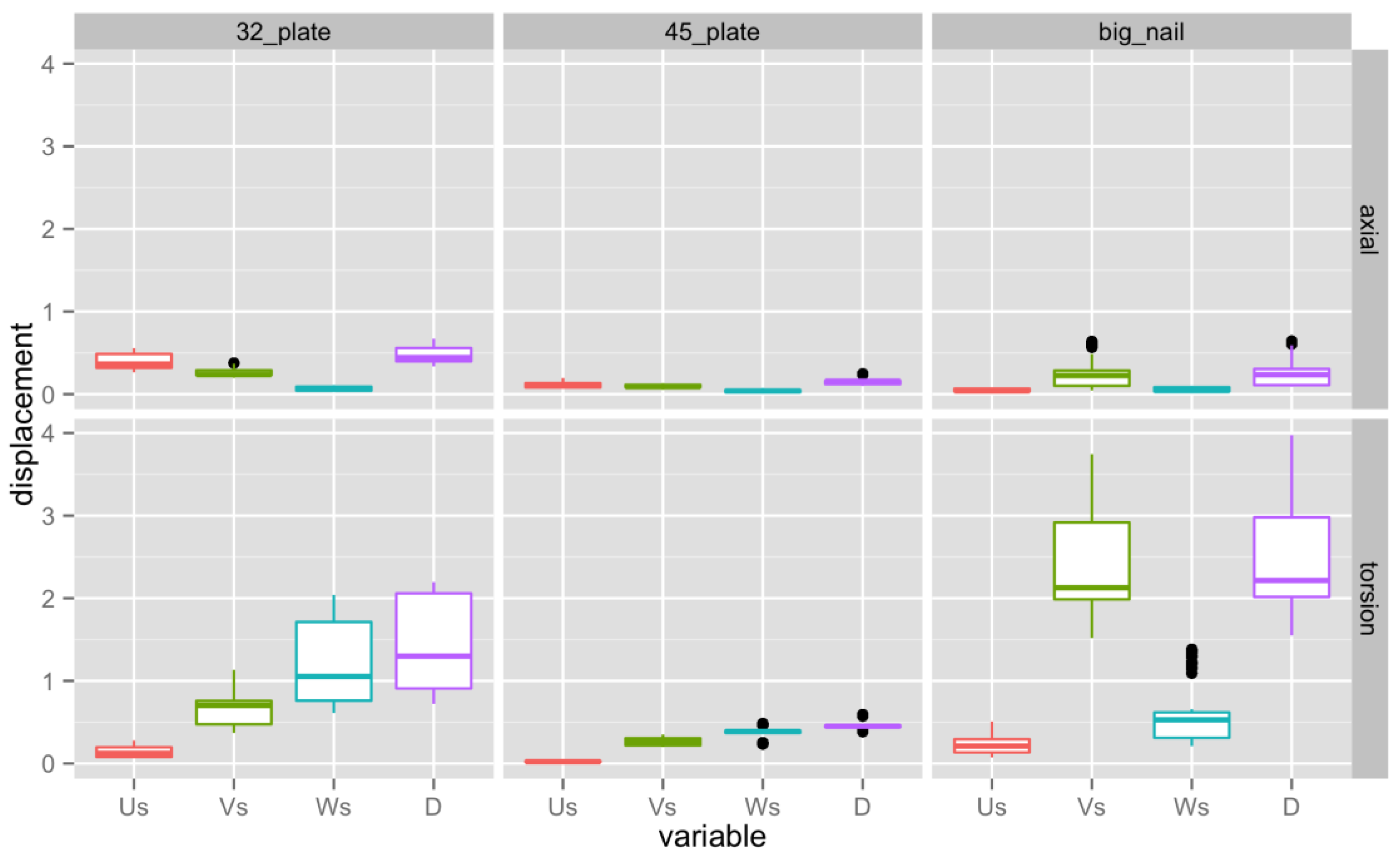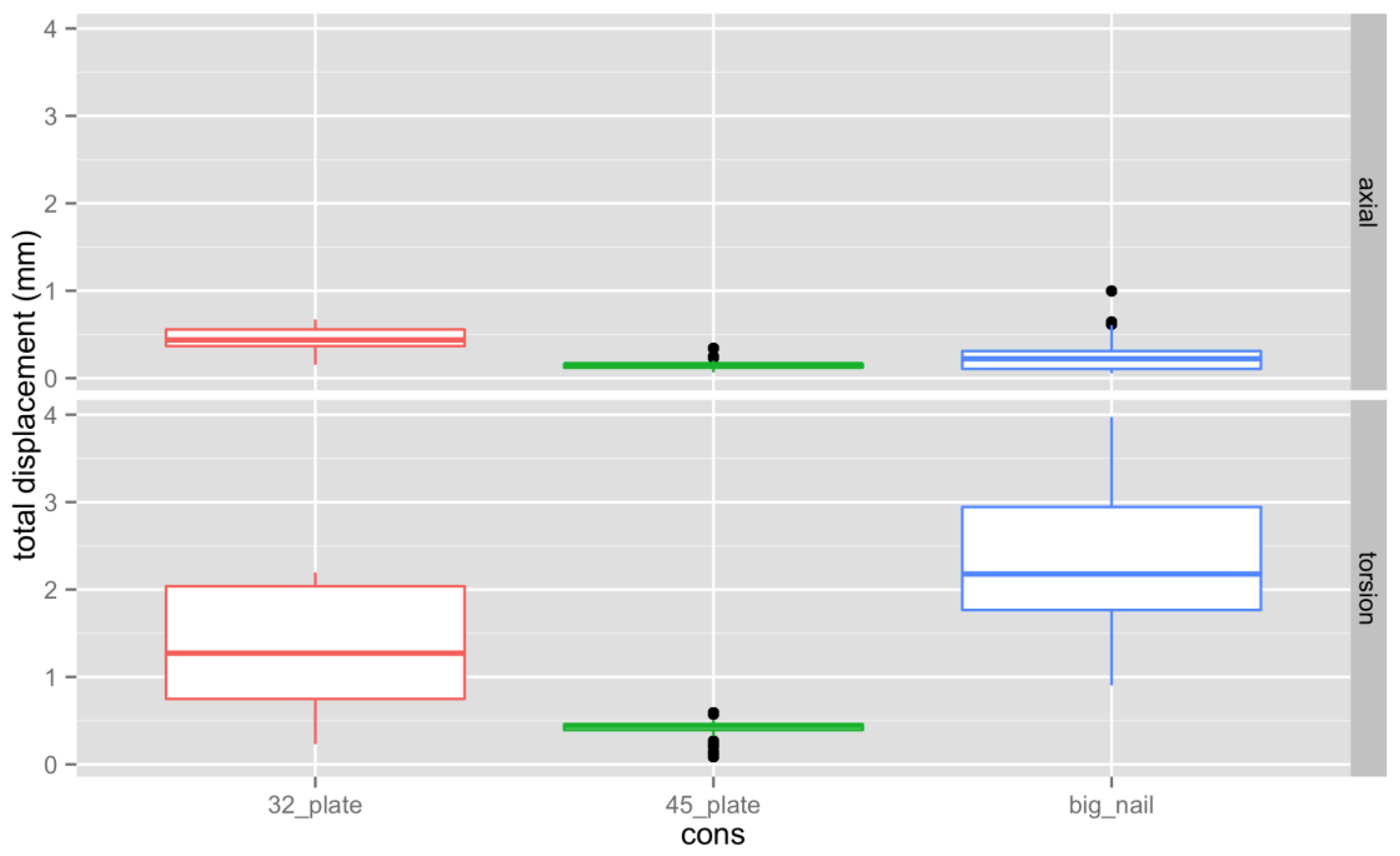Augmentative Plating versus Exchange Intramedullary Nailing for the Treatment of Aseptic Non-Unions of the Femoral Shaft—A Biomechanical Study in a SawboneTM Model
Abstract
1. Article Summary
- The main revision options for aseptic non-unions in femoral shaft fractures after intramedullary nailing without a bony defect are revision intramedullary nailing and augmentative plating.
- Revision intramedullary nailing and augmentative plating using plates of different sizes were evaluated biomechanically in a SawboneTM model of an aseptic non-union of the femoral shaft.
- Augmentative plating using a 4.5 mm LCP leaving the nail in situ is more stable than exchange intramedullary nailing.
- Using a 3.2 mm LCP does not reduce fracture motion sufficiently.
- Strengths: biomechanically based treatment recommendations for the treatment of aseptic femoral shaft non-unions after intramedullary nailing are provided.
- Limitations: no cadaver model was used, but a sawbone model was used. This is less realistic than cadaver bones but has the advantage of uniformity. Only two different plates were used for evaluation.
2. Introduction
3. Materials and Methods
4. Results
4.1. Axial Loading
4.2. Torsional Loading
5. Discussion
6. Strengths
7. Limitations
8. Conclusions
Author Contributions
Funding
Institutional Review Board Statement
Informed Consent Statement
Data Availability Statement
Conflicts of Interest
References
- Garnavos, C. Treatment of aseptic non-union after intramedullary nailing without removal of the nail. Injury 2017, 48 (Suppl. S1), S76–S81. [Google Scholar] [CrossRef] [PubMed]
- Brinker, M.R.; O’Connor, D.P. Management of Aseptic Tibial and Femoral Diaphyseal Nonunions without Bony Defects. Orthop. Clin. N. Am. 2016, 47, 67–75. [Google Scholar] [CrossRef] [PubMed]
- Wiss, D.A.; Garlich, J.; Hashmi, S.; Neustein, A. Risk Factors for Development of a Recalcitrant Femoral Nonunion: A Single Surgeon Experience in 122 Patients. J. Orthop. Trauma 2021, 35, 619–625. [Google Scholar] [CrossRef] [PubMed]
- Kim, J.W.; Yoon, Y.C.; Oh, C.W.; Han, S.B.; Sim, J.A.; Oh, J.K. Exchange nailing with enhanced distal fixation is effective for the treatment of infraisthmal femoral nonunions. Arch. Orthop. Trauma Surg. 2018, 138, 27–34. [Google Scholar] [CrossRef]
- Choi, Y.S.; Kim, K.S. Plate augmentation leaving the nail in situ and bone grafting for non-union of femoral shaft fractures. Int. Orthop. 2005, 29, 287–290. [Google Scholar] [CrossRef]
- Birjandinejad, A.; Ebrahimzadeh, M.H.; Ahmadzadeh-Chabock, H. Augmentation plate fixation for the treatment of femoral and tibial nonunion after intramedullary nailing. Orthopedics 2009, 32, 409. [Google Scholar] [CrossRef]
- Chen, C.M.; Su, Y.P.; Hung, S.H.; Lin, C.L.; Chiu, F.Y. Dynamic compression plate and cancellous bone graft for aseptic nonunion after intramedullary nailing of femoral fracture. Orthopedics 2010, 33, 393. [Google Scholar] [CrossRef]
- Ateschrang, A.; Karavalakis, G.; Gonser, C.; Liener, U.; Freude, T.; Stockle, U.; Walcher, M.; Zieker, D. Exchange reamed nailing compared to augmentation compression plating leaving the inserted nail in situ in the treatment of aseptic tibial non-union: A two-centre study. Wien. Klin. Wochenschr. 2013, 125, 244–253. [Google Scholar] [CrossRef]
- Ateschrang, A.; Albrecht, D.; Stockle, U.; Weise, K.; Stuby, F.; Zieker, D. High success rate for augmentation compression plating leaving the nail in situ for aseptic diaphyseal tibial nonunions. J. Orthop. Trauma 2013, 27, 145–149. [Google Scholar] [CrossRef]
- Park, J.; Kim, S.G.; Yoon, H.K.; Yang, K.H. The treatment of nonisthmal femoral shaft nonunions with im nail exchange versus augmentation plating. J. Orthop. Trauma 2010, 24, 89–94. [Google Scholar] [CrossRef]
- Gao, K.D.; Huang, J.H.; Tao, J.; Li, F.; Gao, W.; Li, H.Q.; Wang, Q.G. Management of femoral diaphyseal nonunion after nailing with augmentative locked plating and bone graft. Orthop. Surg. 2011, 3, 83–87. [Google Scholar] [CrossRef] [PubMed]
- Hakeos, W.M.; Richards, J.E.; Obremskey, W.T. Plate fixation of femoral nonunions over an intramedullary nail with autogenous bone grafting. J. Orthop. Trauma 2011, 25, 84–89. [Google Scholar] [CrossRef] [PubMed]
- Said, G.Z.; Said, H.G.; el-Sharkawi, M.M. Failed intramedullary nailing of femur: Open reduction and plate augmentation with the nail in situ. Int. Orthop. 2011, 35, 1089–1092. [Google Scholar] [CrossRef] [PubMed]
- Lin, C.-J.; Chiang, C.-C.; Wu, P.-K.; Chen, C.-F.; Huang, C.-K.; Su, A.W.; Chen, W.-M.; Liu, C.-L.; Chen, T.-H. Effectiveness of plate augmentation for femoral shaft nonunion after nailing. J. Chin. Med. Assoc. 2012, 75, 396–401. [Google Scholar] [CrossRef] [PubMed]
- Stramazzo, L.; Ratano, S.; Monachino, F.; Pavan, D.; Rovere, G.; Camarda, L. Cement augmentation for trochanteric fracture in elderly: A systematic review. J. Clin. Orthop. Trauma 2021, 15, 65–70. [Google Scholar] [CrossRef]
- DeRogatis, M.J.; Kanakamedala, A.C.; Egol, K.A. Management of Subtrochanteric Femoral Fracture Nonunions. JBJS Rev. 2020, 8, e1900143. [Google Scholar] [CrossRef]
- Passias, B.J.; Emmer, T.C.; Sullivan, B.D.; Gupta, A.; Myers, D.; Skura, B.W.; Taylor, B.C. Treatment of Distal Femur Fractures with a Combined Nail-Plate Construct: Techniques and Outcomes. J. Long Term Eff. Med. Implants 2021, 31, 15–26. [Google Scholar] [CrossRef]
- Cristofolini, L.; Viceconti, M.; Cappello, A.; Toni, A. Mechanical validation of whole bone composite femur models. J. Biomech. 1996, 29, 525–535. [Google Scholar] [CrossRef]
- Bergmann, G.; Deuretzbacher, G.; Heller, M.; Graichen, F.; Rohlmann, A.; Strauss, J.; Duda, G.N. Hip contact forces and gait patterns from routine activities. J. Biomech. 2001, 34, 859–871. [Google Scholar] [CrossRef]
- Schneider, E.; Michel, M.C.; Genge, M.; Zuber, K.; Ganz, R.; Perren, S.M. Loads acting in an intramedullary nail during fracture healing in the human femur. J. Biomech. 2001, 34, 849–857. [Google Scholar] [CrossRef]
- Zhang, H.J.; Wang, S.; Dong, Y.H.; Zheng, W.D.; Sun, Z.; Zheng, J. Successful management of lower limb nonunion using locking plates and bone graft with retention of intramedullary nail. Medicine 2019, 98, e14949. [Google Scholar] [CrossRef] [PubMed]
- Uliana, C.S.; Bidolegui, F.; Kojima, K.; Giordano, V. Augmentation plating leaving the nail in situ is an excellent option for treating femoral shaft nonunion after IM nailing: A multicentre study. Eur. J. Trauma Emerg. Surg. Off. Publ. Eur. Trauma Soc. 2020, 47, 1895–1901. [Google Scholar] [CrossRef] [PubMed]
- Perisano, C.; Cianni, L.; Polichetti, C.; Cannella, A.; Mosca, M.; Caravelli, S.; Maccauro, G.; Greco, T. Plate Augmentation in Aseptic Femoral Shaft Nonunion after Intramedullary Nailing: A Literature Review. Bioengineering 2022, 9, 560. [Google Scholar] [CrossRef] [PubMed]
- Wu, C.C. Exchange nailing for aseptic nonunion of femoral shaft: A retrospective cohort study for effect of reaming size. J. Trauma 2007, 63, 859–865. [Google Scholar] [CrossRef]
- Oh, J.K.; Bae, J.H.; Oh, C.W.; Biswal, S.; Hur, C.R. Treatment of femoral and tibial diaphyseal nonunions using reamed intramedullary nailing without bone graft. Injury 2008, 39, 952–959. [Google Scholar] [CrossRef]
- Shroeder, J.E.; Mosheiff, R.; Khoury, A.; Liebergall, M.; Weil, Y.A. The outcome of closed, intramedullary exchange nailing with reamed insertion in the treatment of femoral shaft nonunions. J. Orthop. Trauma 2009, 23, 653–657. [Google Scholar] [CrossRef]
- Gao, K.D.; Huang, J.H.; Li, F.; Wang, Q.G.; Li, H.Q.; Tao, J.; Wang, J.D.; Wu, X.M.; Wu, X.F.; Zhou, Z.H.; et al. Treatment of aseptic diaphyseal nonunion of the lower extremities with exchange intramedullary nailing and blocking screws without open bone graft. Orthop. Surg. 2009, 1, 264–268. [Google Scholar] [CrossRef]
- Naeem-ur-Razaq, M.; Qasim, M.; Sultan, S. Exchange nailing for non-union of femoral shaft fractures. J. Ayub Med. Coll. Abbottabad 2010, 22, 106–109. [Google Scholar]
- Yang, K.H.; Kim, J.R.; Park, J. Nonisthmal femoral shaft nonunion as a risk factor for exchange nailing failure. J. Trauma Acute Care Surg. 2012, 72, E60–E64. [Google Scholar] [CrossRef]
- Swanson, E.A.; Garrard, E.C.; Bernstein, D.T.; O’Connor, D.P.; Brinker, M.R. Results of a systematic approach to exchange nailing for the treatment of aseptic femoral nonunions. J. Orthop. Trauma 2015, 29, 21–27. [Google Scholar] [CrossRef]
- Lai, P.J.; Hsu, Y.H.; Chou, Y.C.; Yeh, W.L.; Ueng, S.W.N.; Yu, Y.H. Augmentative antirotational plating provided a significantly higher union rate than exchanging reamed nailing in treatment for femoral shaft aseptic atrophic nonunion—Retrospective cohort study. BMC Musculoskelet. Disord. 2019, 20, 127. [Google Scholar] [CrossRef] [PubMed]
- Ru, J.; Xu, H.; Kang, W.; Chang, H.; Niu, Y.; Zhao, J. Augmentative compression plating versus exchanging reamed nailing for nonunion of femoral shaft fracture after intramedullary nailing: A retrospective cohort study. Acta Orthop. Belg. 2016, 82, 249–257. [Google Scholar] [PubMed]
- Park, K.C.; Oh, C.W.; Kim, J.W.; Park, K.H.; Oh, J.K.; Park, I.H.; Kyung, H.S.; Heo, J. Minimally invasive plate augmentation in the treatment of long-bone non-unions. Arch. Orthop. Trauma Surg. 2017, 137, 1523–1528. [Google Scholar] [CrossRef] [PubMed]
- Kontakis, M.G.; Giannoudis, P.V. Nail plate combination in fractures of the distal femur in the elderly: A new paradigm for optimum fixation and early mobilization? Injury 2023, 54, 288–291. [Google Scholar] [CrossRef] [PubMed]
- Jin, Y.F.; Xu, H.C.; Shen, Z.H.; Pan, X.K.; Xie, H. Comparing Augmentative Plating and Exchange Nailing for the Treatment of Nonunion of Femoral Shaft Fracture after Intramedullary Nailing: A Meta-analysis. Orthop. Surg. 2020, 12, 50–57. [Google Scholar] [CrossRef] [PubMed]
- Luo, H.; Su, Y.; Ding, L.; Xiao, H.; Wu, M.; Xue, F. Exchange nailing versus augmentative plating in the treatment of femoral shaft nonunion after intramedullary nailing: A meta-analysis. EFORT Open Rev. 2019, 4, 513–518. [Google Scholar] [CrossRef]
- Medlock, G.; Stevenson, I.M.; Johnstone, A.J. Uniting the un-united: Should established non-unions of femoral shaft fractures initially treated with IM nails be treated by plate augmentation instead of exchange IM nailing? A systematic review. Strateg. Trauma Limb Reconstr. 2018, 13, 119–128. [Google Scholar] [CrossRef]
- Ru, J.Y.; Chen, L.X.; Hu, F.Y.; Shi, D.; Xu, R.; Du, J.W.; Niu, Y.F. Factors associated with development of re-nonunion after primary revision in femoral shaft nonunion subsequent to failed intramedullary nailing. J. Orthop. Surg. Res. 2018, 13, 180. [Google Scholar] [CrossRef]



| Construct | Axial Loading | Torsional Loading |
|---|---|---|
| 3.2 plate | 0.46 | 1.33 |
| 4.5 plate | 0.16 | 0.43 |
| big nail | 0.26 | 2.42 |
| Difference | 99.9% CI | p adj | |
|---|---|---|---|
| big nail versus 4.5 plate | 0.0992 | 0.0847–0.114 | <0.01 |
| 3.2 plate versus big nail | 0.2063 | 0.1917–0.221 | <0.01 |
| 3.2 plate versus 4.5 plate | 0.3055 | 0.2910–0.320 | <0.01 |
| Difference | 99.9% CI | p adj | |
|---|---|---|---|
| big nail versus4.5 plate | 0.891 | 0.825–0.957 | <0.01 |
| 3.2 plate versus big nail | 1.094 | 1.028–1.160 | <0.01 |
| 3.2 plate versus 4.5 plate | 1.985 | 1.919–2.051 | <0.01 |
Disclaimer/Publisher’s Note: The statements, opinions and data contained in all publications are solely those of the individual author(s) and contributor(s) and not of MDPI and/or the editor(s). MDPI and/or the editor(s) disclaim responsibility for any injury to people or property resulting from any ideas, methods, instructions or products referred to in the content. |
© 2023 by the authors. Licensee MDPI, Basel, Switzerland. This article is an open access article distributed under the terms and conditions of the Creative Commons Attribution (CC BY) license (https://creativecommons.org/licenses/by/4.0/).
Share and Cite
Walcher, M.G.; Day, R.E.; Gesslein, M.; Bail, H.J.; Kuster, M.S. Augmentative Plating versus Exchange Intramedullary Nailing for the Treatment of Aseptic Non-Unions of the Femoral Shaft—A Biomechanical Study in a SawboneTM Model. J. Pers. Med. 2023, 13, 650. https://doi.org/10.3390/jpm13040650
Walcher MG, Day RE, Gesslein M, Bail HJ, Kuster MS. Augmentative Plating versus Exchange Intramedullary Nailing for the Treatment of Aseptic Non-Unions of the Femoral Shaft—A Biomechanical Study in a SawboneTM Model. Journal of Personalized Medicine. 2023; 13(4):650. https://doi.org/10.3390/jpm13040650
Chicago/Turabian StyleWalcher, Matthias Georg, Robert E. Day, Markus Gesslein, Hermann Josef Bail, and Markus S. Kuster. 2023. "Augmentative Plating versus Exchange Intramedullary Nailing for the Treatment of Aseptic Non-Unions of the Femoral Shaft—A Biomechanical Study in a SawboneTM Model" Journal of Personalized Medicine 13, no. 4: 650. https://doi.org/10.3390/jpm13040650
APA StyleWalcher, M. G., Day, R. E., Gesslein, M., Bail, H. J., & Kuster, M. S. (2023). Augmentative Plating versus Exchange Intramedullary Nailing for the Treatment of Aseptic Non-Unions of the Femoral Shaft—A Biomechanical Study in a SawboneTM Model. Journal of Personalized Medicine, 13(4), 650. https://doi.org/10.3390/jpm13040650








